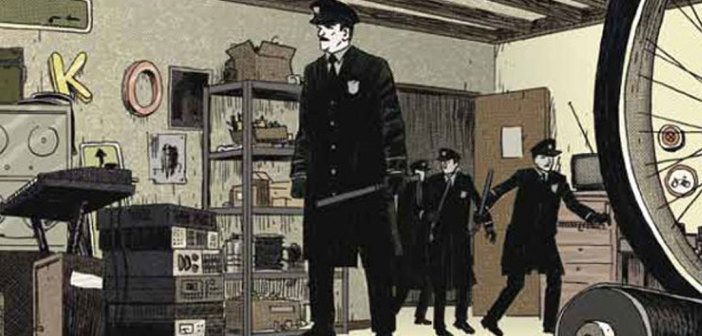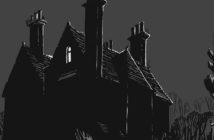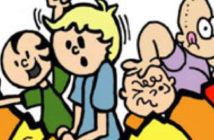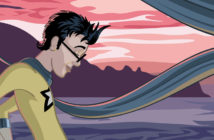One Model Nation as a premise sounds fantastic: a rock band is used as a political symbol to inspire revolution in Europe during the 1970s. The band, One Model Nation, has become the voice of its generation, a voice so feared that it must be suppressed by the powers that be in order to “keep the peace,” an age-old excuse. But the narrative of the book doesn’t read with any of the passion that one would expect; the story comes off more as a small Cliff Notes volume than the subversive graphic novel it’s intended to be.
According to the credits, Image Comics’ One Model Nation was written by C. Allbritton Taylor, who turns out to be Courtney Taylor-Taylor, the lead singer of the Dandy Warhols. He was helped out by the British-born American actor, Donovan Leitch, who is listed as the book’s “historian.” There are two artists: Jim Rugg and Cary Porter. The former illustrated the majority of the book that tells the story of the One Model Nation band, while the latter illustrated the opening and closing sequences that establish the context of the graphic novel. This is certainly no understatement: there was a lot of creative power behind this comic.
As the book opens, readers are given a brief crash course of One Model Nation as a band and its role in 1970s Germany. Sebastian, Karl, Ralf, and Wolfgang are the members, and they are all being hunted by both the police, who want them for supposedly fueling the anarchistic politics of the time, and the Red Army Faction, the infamous (and true-life) terrorist group founded in 1970 by Andreas Baader, Gudrun Ensslin, Horst Mahler, and Ulrike Meinhof.
One Model Nation’s associations with the dissident attitudes of the day are a bit misplaced, if you ask me. The four band members are oftentimes a bunch of insipid stiffs that have an awe-shucks attitude towards everything that happens to them. Call me old-fashioned, but I thought the appeal of leading a rock-and-roll lifestyle was the unlimited access to copious stockpiles of drugs, alcohol, and sex. But Sebastian, Karl, Ralf, and Wolfgang are a foursome of boy scouts, living vanilla lives without any excitement at all. These guys are Hanson, not Motley Crue.
The political violence in Germany increases as the plot progresses, and the finger-pointing at One Model Nation reaches its height, leading to the incarceration of its members. But by the time the arrest happens, I’m uncertain how I should feel. I wanted to ball my fist up in rage, white-knuckled and fuming, and damn the German state for suppressing the creative expressions of four artists. But the passion simply wasn’t there.
But thanks to the wonderful artwork of Jim Rugg, One Model Nation at least looks good as a comic book. Rugg’s illustrations bring the majority of the book to life, and his hand is very careful in trying to accurately portray the mood of the story’s timeframe. His style is bleak and his characters are sallow, which creates a melancholy mood, although enticing. The artwork is complimented by the strict panel layouts and structures, which give the book a smooth visual flow. I don’t know who called the shots here—Taylor, Leitch, or Rugg—but the strong visual organization is a major strength of the comic’s look.
But the negatives of One Model Nation unfortunately outweigh the positives. In a November 2009 interview with Donovan Leitch, Michael Pinto of Fanboy.com asked the creator about the conception of the project. His response: “We both (Veitch and Taylor) have a strong affinity for the music that was coming out of Germany in the mid-seventies, and I began to research what would become One Model Nation. This was an eight-year process that started as a screenplay and ended up a graphic novel. Actually, it was never our intention to write a graphic novel. It wasn’t until Courtney gave the script to Mike Allred that the idea came to shape.”
I find it suspect that One Model Nation wasn’t taken in the direction of a comic book until several years after the idea was originally conceived. I am of the firm belief that comics are comics and film is film. They are not interchangeable based upon flippant whims and bumps in the road. The result here is a muddled plot and flat characters. I’m completely unfamiliar with the politics of Germany in the 1970s, and the book didn’t help to clarify my ignorance. By the end of the One Model Nation, I wasn’t compelled or interested, but simply bored, which is the kiss of death for any comic hoping to incite the elemental passions of art and revolution.
This comic book review originally appeared on Broken Frontier on 19 January 2010.




